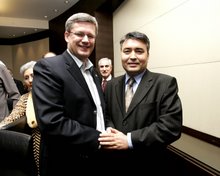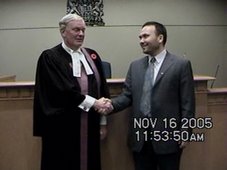A civil rights movement for Uighurs
No peace or reconciliation is possible in Xinjiang while China rides roughshod over Uighurs' rights to shore up its authority
In 1955, a 14-year-old African-American boy named Emmett Till, who had been sent to rural Mississippi to spend the summer with his uncle, was beaten and shot, and then his body was weighed down and dropped into the Tallahatchie River after he was alleged to have made a vulgar pass at Carolyn Bryant, a white woman. Till's body was badly disfigured, but his mother insisted that there be an open casket at his funeral, and up to 50,000 people viewed his body. It took just over an hour for the all-white jury to decide to acquit the two defendants accused of murdering Till – the husband of Carolyn Bryant and his step-brother.
The murder of Emmett Till and the subsequent lack of justice in his case helped spark the beginnings of the American civil rights movement. Just over three months after Till's death, Rosa Parks refused to sit in the back of the bus. Till's murder shocked the world, revealing the severity of the prejudice experienced by African-Americans, particularly in the southern part of the United States. Decades of demonstrations and protests followed, as African-Americans struggled for equal treatment and a greater share of America's freedoms. Riots also rocked major American cities, exposing deep wounds in America's racial landscape.
More than half a century later, and half a world away, rumours that Uighurs at a factory in Shaoguan, in south-eastern China, had raped two Chinese women led a mob of Han Chinese workers to raid the dormitories of Uighur workers and attack them with knives, metal pipes and other weapons. Riot police reportedly took their time in arriving at the scene of the attacks, in the early hours of 26 June. Chinese officials reported that two Uighurs had been killed in the attacks, but Uighurs who witnessed the murders and beatings told the international media that many more had been killed. Immediately following the incident, the Chinese government only indicated that it had punished the disgruntled Chinese man, a former worker at the factory, responsible for spreading the false allegations of sexual molestation. However, there was no official indication that any arrests would be made related to the killings and beatings that took place. (On 7 July, the official Chinese media reported that 13 arrests were made on 5 July that were related to the Shaoguan factory violence.)
On 5 July, Uighurs began taking to the streets in Urumchi, at first peacefully, to protest the killings at Shaoguan and the lack of government action to bring the perpetrators to justice. Many people have questioned how an event that took place so far away (Shaoguan, in Guangdong province, is more than 3,000km away from Urumchi), and why what they perceive as such a small-scale, isolated event sparked so much anger and frustration. I ask people to understand that Uighurs feel much as African-Americans must have felt at the death of Emmett Till and the acquittal of his murderers; and that, just as the murder of Emmett Till sparked resentment and sadness throughout the United States at many decades of deep repression, lynchings, and lack of opportunity, following the Shaoguan violence, Uighurs in East Turkestan and throughout China felt anger and despair rise up over decades of economic, social and religious discrimination, together with the widespread execution, torture and imprisonment of their people.
I in no way endorse any of the violent acts carried out by Uighurs in East Turkestan over the past week. I am absolutely opposed to all violence. However, I believe that, just as the Chinese government misrepresented the facts in the Shaoguan incident, it has, on a much larger scale, grossly misrepresented the truth of the recent protests and violence in East Turkestan. The Chinese government has aggressively promoted a sophisticated, one-sided image of the killings and beatings that have taken place, distributing CDs to international journalists featuring an almost exclusive picture of violence committed by Uighurs against the Han Chinese population. It is irrefutable that acts of violence, including murders, were committed by Uighurs against Han Chinese. However, numerous residents of East Turkestan have told the organisations I lead that they have witnessed the deaths of hundreds of Uighurs that have gone unreported in the official press. At this point, it is impossible to verify these eyewitness accounts, as communications have been virtually cut off between East Turkestan and the outside world. But I cannot ignore the many accounts I have received of unimaginable atrocities that have been covered up.
How can real peace and justice be brought to East Turkestan? This is a difficult question to answer. Real peace cannot be achieved through a lack of transparency; through the 20,000 troops that have been brought in; or through blaming "outside forces", such as myself and the World Uighur Congress, for the turmoil that is now rocking the region. Real peace cannot be achieved through a complete lack of acknowledgment of ethnic discrimination and ethnic disharmony in East Turkestan, such as was exhibited in yesterday's opinion piece by Chinese ambassador Fu Ying. Peace and reconciliation may only begin when China, at the very least, acknowledges the depth and scope of the problems that exist in East Turkestan.
The Chinese government must stop fanning the flames of nationalism within the PRC, and using anti-Uighur anger to shore up its own legitimacy. Instead of blaming "outside forces", it must look within its own borders to examine widespread official repression and officially-promoted ethnic stereotypes. Chinese officials must work to provide job opportunities for Uighurs within East Turkestan and mitigate the severe employment imbalance between Uighurs and Han Chinese in the region. They must provide a forum for the most basic forms of dissent and dialogue between Uighurs and the government. There must be fair trials for those accused of perpetrating violence. And they must allow an independent, international investigation into the events of the past week.
It is hard to imagine the eventual growth of a Uighur civil rights movement, as tens of thousands of troops patrol Urumchi, Kashgar and other cities in East Turkestan. Not much hope for optimism can come from the recent arrest of a Uighur economics professor in Beijing, who merely called for more economic opportunities for Uighurs. And as Chinese officials broadcast rhetoric about the need to execute those found guilty of crimes over the past week, I expect that trials of the accused will not meet international standards. I can only hope against all hope, for the peace and prosperity of everyone in East Turkestan, that things will begin to change.
Tuesday, July 14, 2009
Subscribe to:
Post Comments (Atom)






No comments:
Post a Comment